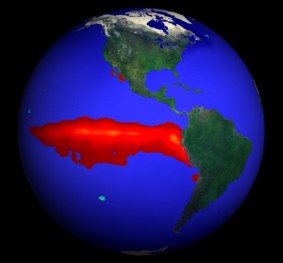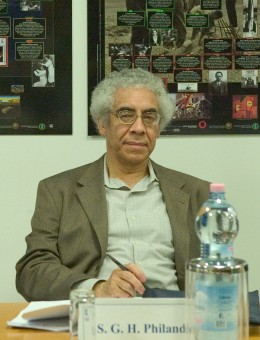Personal tools
News from ICTP 110 - Features - Uncertain World

World-renowned climatologist and ICTP Scientific Council member S. George Philander explores the impact and limitations of science in our modern society.
Science in an Uncertain World
Most people first heard of El
Niño in 1997 when newspapers and television gave extensive
coverage to devastating floods in California, severe droughts
in Indonesia, and strange weather everywhere---all attributed
to El Niño.
Today most people are familiar with the term, but few realise
that the phenomenon has been with us for millennia, and that originally
it was welcomed as a blessing.
The name was initially given to a modest, warm, seasonal current
that appears along the shores of Ecuador and northern Peru around
December when the accompanying rains transform the barren coastal
desert of that region into a garden. El Niño is Spanish
for 'the boy' and refers to Child Jesus.
Over the past few decades, even though the phenomenon has remained
essentially constant, our perceptions of it have undergone a remarkable
transformation. We now regard El Niño as a global hazard
that we anticipate with trepidation.
El Niño is an example of the paradox that, as we grow in
wealth and in population, so does our vulnerability to natural
hazards. Insurance companies find that claims related to damages
inflicted by severe storms, hurricanes, floods and earthquakes
are rising steeply even though there is no evidence of an increase
in the number and intensity of those hazards. For example, today
El Niño still turns the desert of Ecuador and northern
Peru into a garden, but few people have time to behold that miracle;
they are preoccupied with the roads, bridges and houses that are
washed away by the rains.

3D view of El Nino phenomenon
To cope with environmental hazards we turn to scientists for predictions.
Meteorologists have responded by transforming weather prediction
from an augury into a source of reliable information. Attention
has recently shifted to the prediction of longer-term climate
fluctuations. Progress has been so rapid that, although El Niño
caught everyone by surprise in 1982, by 1997 scientists anticipated
its arrival in the Pacific several months in advance. This was
an impressive achievement, but it carried a most unfortunate blemish.
During the summer of 1997 scientists alerted Californians, on
television and in newspapers, of a high probability for exceptionally
heavy rains during the winter of 1997-1998 because of a very intense
El Niño. Scientists also advised the people of Zimbabwe
that rainfall there would probably be below normal. Californians
did indeed experience floods, and were prepared, but Zimbabweans
had normal rainfall and were unprepared. Because of the expectation
that crops would be poor, and that farmers would be unable to
pay back loans, financial institutions in Zimbabwe declined loans
to farmers. The consequences were dire: Crop production fell 20
percent below normal. The prediction of a drought in effect caused
a drought.
The tragedy in Zimbabwe underlines the urgent need to improve
communications between producers and users of scientific information.
The latter group faces by far the bigger challenge because the
decisions it has to make are extremely difficult, even when the
scientific information is perfectly accurate. Available resources
to cope with a multitude of problems that range from public health
to agriculture and education are limited. Any setting of priorities
reflects values that depend on race, gender, religion and culture,
making the formulation of policies acceptable to everyone difficult.
Given the enormous complexity of social issues, we must guard
against exaggerating the value of scientific information. Consider
the case of the Indian monsoons.
In the second half of the 19th century, poor rains over India
often contributed to poor harvests, famines and the death of millions
of people. At the time, it was assumed that the solution to the
problem required scientific information that would allow accurate
predictions of the monsoons.
Today scientists have a much better understanding of monsoons
than they did 100 years ago, but they are still unable to predict
accurately when monsoons will arrive or, for that matter, will
fail to arrive. Nonetheless for several decades now, there have
been no disasters comparable to the famines of the 19th and early
20th century. Of prime importance to this impressive achievement
are political changes in India. Development and implementation
of effective policies to cope with famines started once India
became an independent country and acquired a democratic government.
Science has played a secondary role.
Although much progress can be made on certain environmental problems
even in the absence of scientific information, we need to acknowledge
that such information can be valuable, especially if it is accurate.
For example, government officials now act swiftly in response
to predictions that a hurricane will make landfall. As recently
as World War II the admiral of a fleet in the Pacific chose to
ignore the prediction of a typhoon because of a lack of confidence
in the prediction. His fleet suffered enormous losses. Because
of advances in weather prediction such a decision on the part
of an admiral would be unthinkable today.
Progress in weather forecasting comes from improved measurement
networks, better understanding of such weather phenomena as fronts,
tornadoes, hurricanes and cyclones, and frequent tests of the
theories and models of meteorologists. Of central importance is
a balance between science for the sake of science and science
for practical purposes.
Finding a similar balance in the case of El Niño studies
is proving difficult. During the cold war, scientists studying
El Niño enjoyed considerable freedom to explore a beguiling
phenomenon mainly for the sake of understanding it. They made
rapid progress and, after the exceptionally intense El Niño
of 1982, could explain what had happened. However, they failed
to sound a public alert beforehand, in part because there was
no pressure to do so. Sponsors of scientific research subsequently
insisted on useful results. This emphasis on science for practical
purposes contributed to a significant increase in the number of
scientists involved in social and policy issues related to environmental
problems. In principle, this is a laudable development, but in
practice it is fraught with dangers, as the tragedy in Zimbabwe
illustrates.
For science to flourish, scientists must have a sceptical attitude
towards their own results, constantly questioning and testing
apparent solutions to problems. When trying to persuade potential
clients that those results are useful and merit attention, they
have to adopt a very different attitude, one of confidence in
their results. This is not a problem in the case of weather forecasting
for tomorrow because the accuracy of the forecasts can be checked
immediately. However, it is a serious dilemma in the case of predictions
related to infrequent environmental phenomena that develop over
months and longer.
El Niño forecasts have huge uncertainties at present. Is
such information of any value at all? Consider the daily weather
forecasts that the British government started making available
to the public in the 1860s. Scientists objected and forced the
government to halt those forecasts on the grounds that the predictions
had huge uncertainties and were not based on any understanding
of weather phenomena. After a public outcry, the forecasts were
resumed because they were proving useful, especially to those
involved in coastal shipping. The forecasts significantly reduced
the number of shipwrecks, and therefore saved many lives. Scientific
information with large uncertainties can be of considerable value,
but such an evaluation is best made by the public, not by scientists.

S. George H. Philander
The worlds of science and of human affairs are radically different.
Each scientific problem, in principle, has a well-defined solution
that can be found by means of universal methods independent of
race, gender or religion. A social problem, by contrast, has a
multitude of solutions, each with advantages and disadvantages
that are weighed differently in different cultures.
The methods and skills required to solve the problems encountered
in the cold, uncompromising world of science have very limited
applicability in the heated, nuanced world of human affairs where
compassion is a virtue and compromise a requisite.
Scientists live in both worlds and thus face a dilemma. The most
effective way to minimise this quandary is to reduce the uncertainties
in scientific results. To achieve that goal the producers and
also the sponsors of scientific research should strive for a balance
between science for the sake of science and science for practical
benefits.
S. George Philander
Princeton University,
ICTP Scientific Council
This article includes excerpts from the author's recent book, Our Affair with El Niño; How we transformed an enchanting Peruvian current into a global climate hazard (Princeton University Press, 2004.)